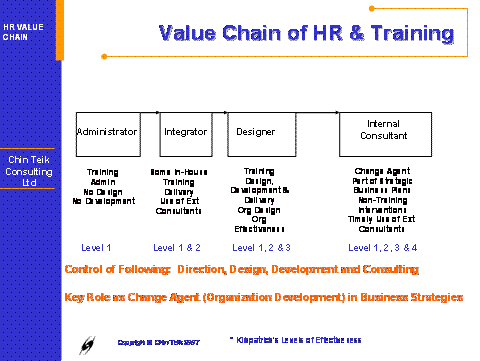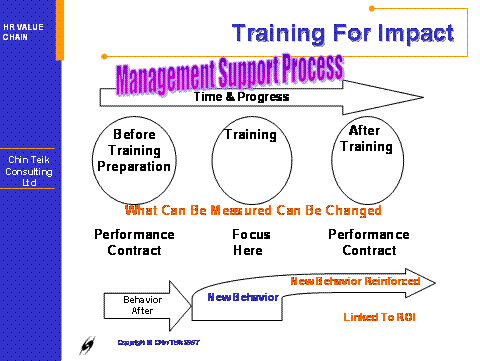 |
| Home | About Chin Teik Consulting Ltd. | Impact of Consulting | Products | Services | Association | Contact Us |
| |
| Moving Up The Training Value Chain - Part II - Training Strategies for Organizational Impact |
|
Key messages of this article are:
When I was a training and development manager for a factory and a regional sales and marketing organization I was moving in the circle of training managers and HR managers. Today as a consultant on organizational and leadership effectiveness, I am also working with client organizations that have training departments. One of the key visions of these training or HR organizations that I have seen now for the last 15 years or more is the statement of ‘wanting to be a strategic business partner to the operations group. Up to today, I still see a lot of support organizations wanting to be that but in many cases not having a structured approach to become that. I hope this article gives you some ideas of where to start, do less of and do more of. Good luck!
Before we go any further, let us scope the problem statement. To do that let us begin with the end state or success measurement. Let us ask ourselves ‘what does success look like’ if we are truly a strategic business partner to the Operations? What is your value proposition to the business given that training is a cost center and not a P&L center? Let me suggest a few things for you to think about:
So the first area to work on is to shift how you see the world. If you see HR or training as being only a supporting role and one that takes orders and direction then it will be harder to influence the organization to do the right things. If HR strategies are kept separate to business planning and discussions then it becomes harder to link whatever HR or Training does with business solutions. However if you see HR and Training being an expert in organization and leadership development then you need to behave like an expert who can link the programs or processes with business strategies and results.
The key elements of a value chain of HR have to do with the control of knowing where the organization is heading (knowledge and inside track), design and development and being in a position to consult with the organization on business strategies and solutions. You can also see from the diagram that I have correlated Kirkpatrick’s level of training effectiveness with where you are in the value chain. So the key question is where are you in this value chain and what do you want to do to move up the value chain if you are in the administrator or integrator role?
Figure 1: Value Chain of HR and Training For those who would like an overview about Dr. Kirkpatrick’s 4 levels of training effectiveness, please refer to Part I of this 2 part article. The essential characteristics of a value-add HRD and Training organization, in my opinion, are the following:
Step 1 – Identifying accurately the Problem Statement (What are we trying to solve?) Step 2 – Focusing on Vital Few Behavioral Outcomes vs. Trivial Many when it comes to Root Cause Analysis Hint: To be a change agent you have to be an expert in a few things. One of them is problem solving. I use that all the time in my career and now as a consultant. Those problem solving steps never fail me. It also gives you credibility in the eyes of your business clients. Don’t be a ‘jack of all trade’ be a ‘master of few’. Step 3 – Designing a truly impactful solution in the form of either training or non-training interventions or both Step 4 – Delivering the solution and implementation approaches Step 5 – Creating a Pre and Post Management Support Process to guarantee transfer of behavior change in classroom to workplace For Step 5, let us look at how the Management Support Process works. If you look at the diagram below, I use a few principles in designing a Management Support Process. First is the adult learning principle that ‘adults learn best when he/she has a problem to solve’. Second is ‘what you measure will change’. Third is ‘what gets rewarded against my performance plan will get attention.’ So prior to sending an employee for training, a manager needs to set up the problem statement with the employee. Best thing to do is to link to the employee’s performance plan and areas he or she is working on to close for better performance. Pick a particular behavior and then set up the expectation of the behavior change expected after the training. Hint: from my experience with lots of clients, do not underestimate the difficulty to start to think in terms of behavioral statements. Also set up time after the training to follow up with a meeting to have the employee share what he or she has learned and how he or she will be applying back at work. Post training is important that you follow up with the meeting. It is also important that when you see the employee trying to apply the new behavior or new tool, you need to give just-in-time positive feedback on the specific new behavior the employee is trying to demonstrate.
Figure 2: Management Support Process The highest recognition to achieve is when the organization will always involve HR and Training on any decisions on organizational direction or changes! The key to branding your training value is to constantly ask for feedback at the start, during the training and immediately after the training. Feedback is the breakfast of champions. Without it, you will not know whether you are solving the problems needed to be solved. Asking for immediate feedback is good and the clients will need to be consistent in what they say to you and what they put into any customer satisfaction survey later in the year. Another simple way is to treat your products with dignity by not putting them into acronyms like MDP (for Management Development Program) or P-S (for problem solving). I always insist in calling out my programs in full. Why? So that people remember my products. If you put your programs into short form and like most other products in the company, how will anyone remember? Also remember that people can get creative and find other meaning for P-S or MDP or whatever. Lastly the power of branding comes from perception that the products or services you have offered are making an impact on the organization and nothing beats that then real results (go after behavior change linked to results) and satisfied clients’ feedback. Go for less volume and more impact! Organization cannot have their employees spend all their time in classrooms with no impact to the business.
Chin Teik Consulting Ltd can discuss with you on how to implement ideas from this article in your organization. This 2 day workshop can be tailored to your specific needs with in-house consulting & executive coaching with follow up on implementation roadmap. Please email us and we can discuss further on your concerns or needs.
Cheah Chin Teik is founder and President of Chin Teik Consulting Ltd., based in Hong Kong. Chin Teik is an experienced coach in organizational and leadership effectiveness for business results, scale-ability and sustainability via alignment and engagement of entire workforce. Chin Teik facilitates senior executive and/or executive teams to a clearer understanding of their leadership behavior while embedding a system of management practices to deliver business results. Renowned worldwide for his dynamic and intuitive consulting process, Chin Teik’s specialization areas are executive coaching and/or executive team coaching on strategic planning system and processes, organization effectiveness, leadership and management development and system of management implementation. Chin Teik also specializes in enabling ‘HR and Training strategies for organizational impact’ and implementing ‘Continuous Improvement Process’. Chin Teik’s coaching and consulting efforts cut across a wide range of industries including Legal, Water Utility, Elevator, Oil & Gas, Advertising, Packaging, Precision Engineering and Semiconductor A charismatic global leader, Chin Teik has amassed invaluable experience in manufacturing, training & development, total quality management and over 28 years of experience playing critical human resource roles in Intel on a regional and global scale. Chin Teik has to his credit the prestige of setting up the first-ever 10, 000 sq. ft. Intel University Training Center to deliver ‘Transformation of Workforce’ program to entire factory. Chin Teik also played an instrumental role in the founding of the Penang Skills Development Center. ‘He knows his work and is able to answer questions using personal experiences’ ‘Clear articulation with specific real life experiences’ ‘Chin Teik’s delivery is passionate, clear, visionary and yet practical. I didn’t blink an eyelid. I wanted to hear it all’. ‘Chin Teik pushed and challenged our mental model state and opened our eyes to how we can do things differently. We are able to apply ‘performance contract’, ‘blocking time for planning’, ‘simple TNA’, ‘problem solving through facilitation’, ‘management support process’.’ Copyright © 2007 Chin Teik Consulting Ltd
|
| Home | About Chin Teik Consulting Ltd. | Impact of Consulting | Products | Services | Association | Contact Us |

